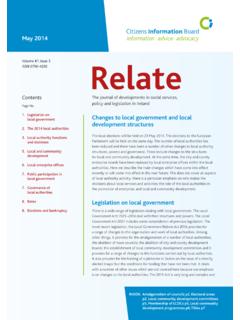Transcription of 2. Geographical distribution - CSO
1 2. Geographical distribution Population by constituency Urbanisation Urban centres Geographical distribution Population by constituency Figure Population per TD in each constituency, 2016. The population by constituency is an important output from each census as the total membership of the D il is determined by the population as measured in the Limerick County census. The constituencies presented in Figure Clare are those of the 44th D il as defined in the Electoral Roscommon-Galway (Amendment) ( ) Act 2013. Cork South-West Waterford The population per TD for the country as a whole in April Limerick City 2016 was 30,138. Wicklow Dublin Mid-West There were twenty five constituencies with more than 30,000 people per TD and an additional eleven Kerry constituencies where the number of people per TD was Offaly in the range 29,000 to 30,000.
2 Cork North-West Tipperary The constituency of Limerick County, with 27,948 Sligo-Leitrim people, had the lowest population per TD in the country Dublin South-Central in April 2016. Wexford Mayo The constituency of Dublin North-West had the highest Dublin South-West with 32,331 people. Donegal Meath West Dublin Central was the fastest growing constituency Louth increasing by 7,277 people or per cent. It recorded Longford-Westmeath the second highest population per TD with 32,102. people. Dublin Bay South Carlow-Kilkenny Only two constituencies, Donegal and Mayo, showed a Cork East population decrease between the two censuses falling Meath East by per cent and per cent respectively. Dublin Fingal Dublin West See web table EY003 Cork South-Central Dublin Bay North Kildare South Kildare North Laois Table Persons represented by constituency type, 2016.
3 Galway West Size type of constituency D n Laoghaire 5 members 4 members 3 members Cavan-Monaghan Number of Cork North-Central constituencies 11 16 13. Galway East Dublin Rathdown Total persons Dublin Central represented 1,656,194 1,926,080 1,179,591. Dublin North-West 27 28 29 30 31 32 33. Average persons represented 30,113 30,095 30,246 '000s 14. Geographical distribution Urban population growth continues The population of large towns increased by 48,269. people, or per cent, while that of the smallest towns While the population overall increased by per cent (1,500 to 2,999) remained static. over the five years between April 2011 and April 2016. the population of Dublin city and suburbs increased by Figure below represents the population by urban /.
4 Per cent indicating a growing share of the population rural type and vividly illustrates the increasing share of living in the capital. There were 62,552 more people in the urban population over the past fifty years. While the Dublin in 2016 than five years previously. population of rural areas has increased by per cent over the period that of urban areas has increased by There were 2,985,781 people in urban areas in Ireland in more than four times that rate with an increase of 2016. This represents an increase of 138,899 or per per cent over the same period. cent on 2011. In contrast, the population of rural areas increased by just 34,714 people, a 2 per cent rise. See web table EY003. Table Population of urban areas, 2011 and 2016.
5 Population Area 2011 2016 Actual change Dublin city & suburbs 1,110,627 1,173,179 62,552. Cork city & suburbs 198,582 208,669 10,087. Limerick city & suburbs 91,454 94,192 2,738. Galway city & suburbs 76,778 79,934 3,156. Waterford city & suburbs 51,519 53,504 1,985. Towns 10,000 or over 730,415 778,684 48,269. Towns 5,000 -9,999 297,174 294,020 -3,154. Towns 3,000 -4,999 119,705 132,913 13,208. Towns 1,500 -2,999 170,628 170,686 58. Urban Total 2,846,882 2,985,781 138,899. Rural Total 1,741,370 1,776,084 34,714. Total 4,588,252 4,761,865 173,613. Figure Urbanisation, 1966 - 2016. Urban areas Urban areas Rural Rural areas areas 1966 1971 1979 1981 1986 1991 1996 2002 2006 2011 2016. Dublin city & suburbs Cork city & suburbs Other three main cities Towns 10,000 or over Towns 5,000 -9,999 Towns 1,500 - 4,999.
6 Rural 15. Geographical distribution More and larger urban centres Figure Share of population in urban areas, 1966 and 2016. The table below shows the number of urban centres classified by type along with the increase in the respective populations. The total number of urban centres increased from 197. in 2011 to 200 in 2016 (for definitions, see Appendix 3). Small towns with population between 3,000 and 4,999. 2016 39% 7% 8% 26% 10% 10%. people were the fastest growing category, increasing their population by 11 per cent since 2011 and by per cent since 2006. Two towns (Longford and Skerries) joined the category of 10,000 or more ( large towns) since the last census, bringing the total number to 41.
7 The population of all large towns increased by per cent, and by per cent since 2002. 1966 51% 9% 8% 10% 10% 13%. Table Number of urban population centres, 2011 and 2016. Population centres Area 2011 2016 % change Dublin city & suburbs 1 1 Dublin city Cork city & suburbs 1 1 Limerick city & suburbs 1 1 Cork city Galway city & suburbs 1 1 Waterford city & suburbs 1 1 Other 3 main cities Towns 10,000 or over 39 41 Towns 5,000 -9,999 41 40 Towns 3,000 -4,999 30 33 Towns 10,000 +. Towns 1,500 -2,999 82 81 Urban Total 197 200 Towns 5,000 - 9,999. Towns 1,500 - 4,999. Shifting share . Figure clearly shows how Dublin city has lost population share of the total urban population at the expense of other urban areas over the past fifty years.
8 In 1966 Dublin city accounted for over half the urban population of the country with 51 per cent living there. In April 2016 this had fallen to 39 per cent. This fall has been offset by the growth of large towns. In 1966, 1 in 10 people in urban areas lived in this category of town, compared with more than 1 in 4 in 2016. 16. Geographical distribution It's a fact! 200 The total number of urban centres in 2016. 11% The percentage increase in the population of small towns - the fastest growing category The percentage increase in the population of large towns - the second fastest growing category 26% The percentage of the urban population living in large towns in 2016. 51% Dublin's share of the urban population in 1966.
9 39% Dublin's share of the urban population 50. years later 17.









